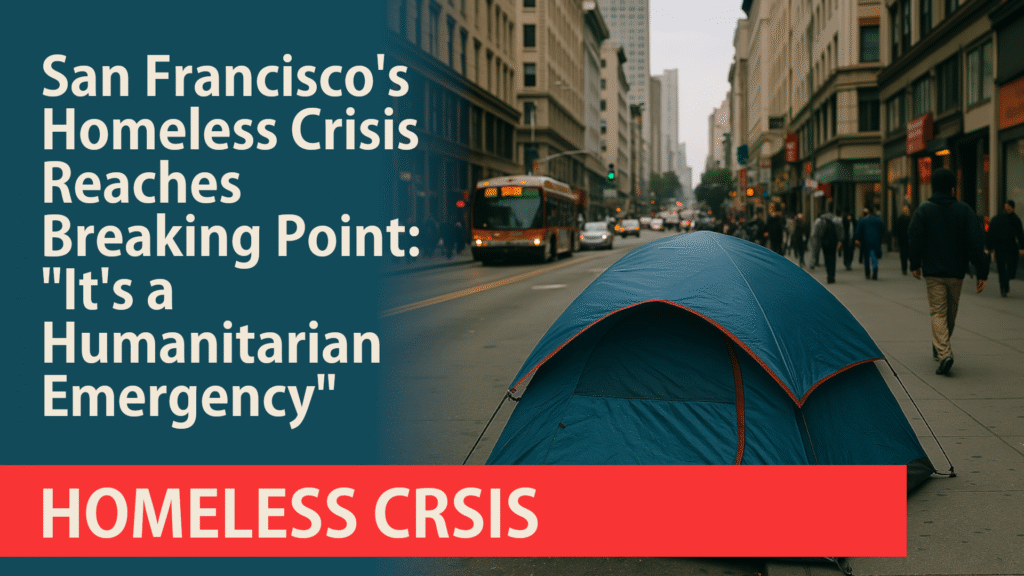
San Francisco is facing a spiraling homeless crisis that city officials are now calling a full-blown humanitarian emergency, as tents, encampments, and makeshift shelters stretch from the Embarcadero to the Outer Sunset. According to newly released figures from the San Francisco Department of Homelessness and Supportive Housing, the number of unhoused individuals has surged past 13,000 — a 22% increase from just two years ago.
Civic leaders and residents alike are sounding the alarm.
“We’re past the point of frustration. This is a collapse,” said Supervisor Linda Choi during an emergency Board of Supervisors session on Tuesday. “Our streets are not just failing the people who live in homes — they’re utterly failing the people who don’t.”
Encampments Expand, Services Strain
Downtown, sidewalks have become crowded with sprawling encampments, many of them erected directly outside tech offices, luxury condos, and shuttered retail spaces. Civic Center Plaza, once home to food trucks and family events, now resembles a refugee camp. At least 4,200 tents were counted across the city in a recent volunteer survey.
Emergency medical services report a 37% increase in calls from encampment areas. “We’re seeing a rise in untreated mental illness, overdoses, and violence within the camps,” said Dr. Jameela Roarke, head of SF General’s outreach response team. “We don’t have enough beds, we don’t have enough doctors, and frankly, we don’t have enough time.”
Local Businesses Caught in the Middle
Storefront owners say they are under siege — not by crime, but by the growing desperation of their neighbors. “We’re not blaming people for being unhoused,” said Marvin Liu, owner of a family-run café in SoMa. “But I’ve had three break-ins in the past month, and I had to start closing at 4 p.m. to keep my staff safe. We’re on the edge.”
The San Francisco Chamber of Commerce estimates the city has lost over $1.2 billion in business revenue in the last 18 months due to public safety concerns and declining tourism.
Temporary Shelters at Capacity
City-funded shelters and safe sleeping villages are now operating at 102% capacity. The highly publicized Navigation Centers — meant to serve as short-term landing zones — are turning people away daily.
Mayor Elena Torres, in a press conference Wednesday, called for “urgent state and federal intervention.”
“We cannot fix this with tents and token programs,” the mayor said. “We need immediate funding for permanent supportive housing, robust mental health services, and coordinated outreach that treats this like the public health disaster it is.”
Critics Point to Policy Gridlock
Advocates and former city officials argue that policy failures, NIMBYism, and inconsistent enforcement have allowed the crisis to deepen. “We’ve spent more than $1 billion in the last five years on homelessness,” said former city planner Marcus Alton. “Yet we’re worse off. Why? Because every solution gets stalled in red tape or political fighting.”
Meanwhile, voters are growing impatient. A new poll conducted by BayMetrics shows 68% of residents say homelessness is the number one issue facing the city — up from 42% just last year.
A City at a Crossroads
On the corner of Mission and 16th, a man named Ray sleeps under a tarp near a shuttered BART entrance. A former construction worker, he’s been unhoused for three years. “I didn’t choose this. I lost my job. Then my place. Then everything else,” he said. “People walk by like I’m invisible. But we’re still here. We’re still people.”
With summer approaching and no long-term plan in sight, San Francisco faces a defining test — not only of governance, but of its capacity for compassion.
“San Francisco has always called itself a progressive city,” said Dr. Roarke. “Now it has to prove it — or watch itself unravel.”